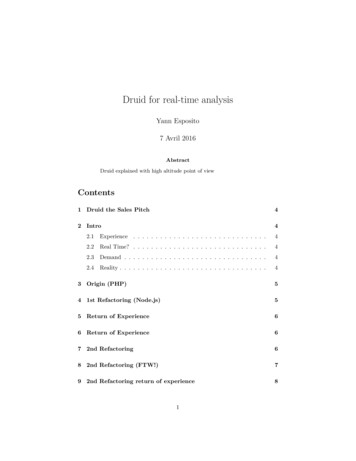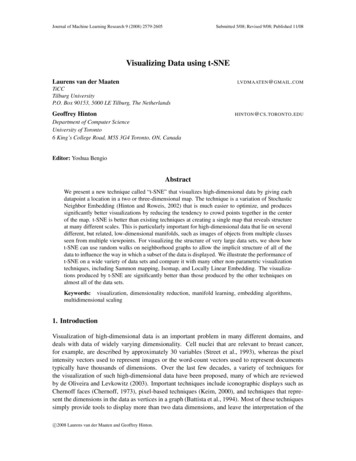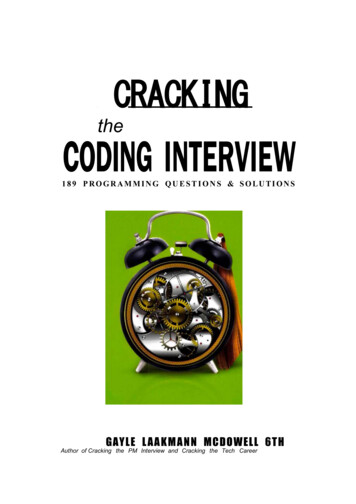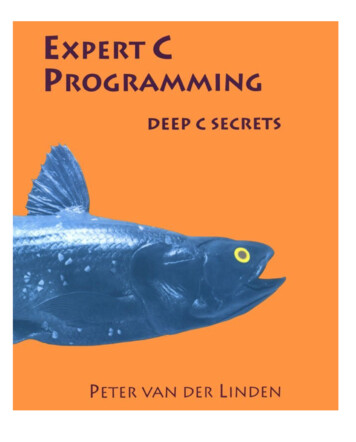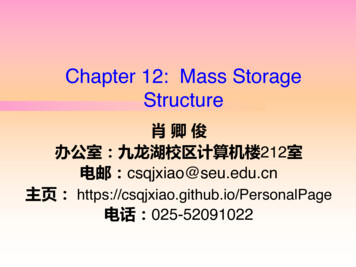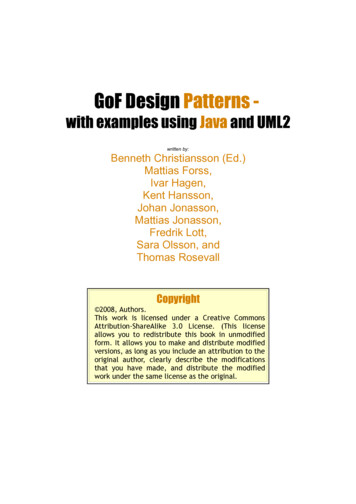
Transcription
GoF Design Patterns with examples using Java and UML2written by:Benneth Christiansson (Ed.)Mattias Forss,Ivar Hagen,Kent Hansson,Johan Jonasson,Mattias Jonasson,Fredrik Lott,Sara Olsson, andThomas RosevallCopyright 2008, Authors.This work is licensed under a Creative CommonsAttribution-ShareAlike 3.0 License. (This licenseallows you to redistribute this book in unmodifiedform. It allows you to make and distribute modifiedversions, as long as you include an attribution to theoriginal author, clearly describe the modificationsthat you have made, and distribute the modifiedwork under the same license as the original.
Logica Java Architects Training CrewDesign Patterns- ExplainedTable of ContentsChapter 1 Creational Patterns3Chapter 2 Structural Patterns24Chapter 3 Behavioral Patterns50Factory, Abstract Factory, Builder, Prototype and SingletonAdapter, Bridge, Composite, Decorator, Facade, Flyweight and ProxyChain-of-responsibility, Command, Iterator, Mediator, Memento, Observer,State and StrategyForewordThis book is the result of a joint effort of the authors with an equalcontribution from all. The idea to the book originated during theparticipation of a Java Architect training program taught at Logica SverigeAB Karlstad office. During the course the authors identified the lack of aquick-guide book to the basic GoF1 design patterns. A book that could beused as a bare bone reference as well as a learning companion forunderstanding design patterns. So we divided the workload and together wecreated an up-to-date view of the GoF design patterns in a structured anduniform manner. Illustrating the choosen patterns with examples in Java anddiagrams using UML2 notation. We have also emphasized benefits anddrawbacks for the individual patterns and, where applicable. We alsoillustrate real world usage situations where the pattern has successfully beenimplemented.I personally as editor must express my deepest admiration for the dedicationand effort the authors have shown during this process, everyone who everhave written a book knows what I mean. I am really proud to be the editor ofthis very usable book.--- Benneth Christiansson, Karlstad, autumn 2008 ---1 Design Patterns Elements of Reusable Elements by Gamma, Helm, Johnson and Vlissides (1995)2
Logica Java Architects Training CrewDesign Patterns- ExplainedChapter 1 Creational Patterns“Creational design patterns are design patterns that deal with objectcreation mechanisms, trying to create objects in a manner suitable to thesituation. The basic form of object creation could result in design problemsor added complexity to the design. Creational design patterns solve thisproblem by somehow controlling this object creation.”2All the creational patterns define the best possible way in which an objectcan be created considering reuse and changeability. These describes the bestway to handle instantiation. Hard coding the actual instantiation is a pitfalland should be avoided if reuse and changeability are desired. In suchscenarios, we can make use of patterns to give this a more general andflexible approach.2 http://en.wikipedia.org/wiki/Creational pattern3
Logica Java Architects Training CrewDesign Patterns- ExplainedFactory PatternDefinitionThe Factory pattern provides a way to use an instance as a object factory.The factory can return an instance of one of several possible classes (in asubclass hierarchy), depending on the data provided to it.Where to use When a class can't anticipate which kind of class of object it must create. You want to localize the knowledge of which class gets created. When you have classes that is derived from the same subclasses, or theymay in fact be unrelated classes that just share the same interface. Eitherway, the methods in these class instances are the same and can be usedinterchangeably. When you want to insulate the client from the actual type that is beinginstantiated.Benefits The client does not need to know every subclass of objects it must create. Itonly need one reference to the abstract class/interface and the factoryobject. The factory encapsulate the creation of objects. This can be useful if thecreation process is very complex.Drawbacks/consequences There is no way to change an implementing class without a recompile.4
Logica Java Architects Training CrewDesign Patterns- ExplainedStructureSmall exampleThis example shows how two different concrete Products are created usingthe ProductFactory. ProductA uses the superclass writeName method.ProductB implements writeName that reverses the name.public abstract class Product {public void writeName(String name) {System.out.println("My name is " name);}}public class ProductA extends Product { }public class ProductB extends Product {public void writeName(String name) {StringBuilder tempName new y reversed name is" tempName.reverse());}}public class ProductFactory {Product createProduct(String type) {if(type.equals("B"))return new ProductB();elsereturn new ProductA();}}5
Logica Java Architects Training CrewDesign Patterns- Explainedpublic class TestClientFactory {public static void main(String[] args) {ProductFactory pf new ProductFactory();Product prod;prod pf.createProduct("A");prod.writeName("John Doe");prod pf.createProduct("B");prod.writeName("John Doe");}}When TestClientFactory is executed the result is:c: My name is John Doec: My reversed name is eoD nhoJUsage exampleThe Connection object in the java package sql is a factory.Depending on the database driver you use you get the database vendorsimplementation of the Statement interface. In the following example weactually get an OracleStatement object from the package oracle.jdbc.driverwhen calling createStatement.6
Logica Java Architects Training CrewDesign Patterns- Explainedimport java.sql.*;public class TestClientFactoryUsage {static Connection con;static Statement stmt;public static void main(String[] args) {try con DriverManager.getConnection("myServer", "user","password");stmt con.createStatement();} catch(Exception e) {}}}7
Logica Java Architects Training CrewDesign Patterns- ExplainedAbstract Factory PatternDefinitionThe Abstract Factory pattern is a creational pattern which is related to theFactory Method pattern, but it adds another level of abstraction. What thismeans is that the pattern encapsulates a group of individual concrete factoryclasses (as opposed to concrete factory methods which are derived insubclasses) which share common interfaces. The client software uses theAbstract Factory which provides an interface for creating families of relatedor dependent objects without specifying their concrete classes. This patternseparates the implementation details of a set of objects from its generalusage.Where to useThe pattern can be used where we need to create sets of objects that share acommon theme and where the client only needs to know how to handle theabstract equivalence of these objects, i.e. the implementation is notimportant for the client. The Abstract Factory is often employed when thereis a need to use different sets of objects and where the objects could beadded or changed some time during the lifetime of an application.BenefitsUse of this pattern makes it possible to interchange concrete classes withoutchanging the code that uses them, even at runtime.Drawbacks/consequencesAs with similar design patterns, one of the main drawbacks is the possibilityof unnecessary complexity and extra work in the initial writing of the code.8
Logica Java Architects Training CrewDesign Patterns- ExplainedStructureBelow you see the class diagram of the following small example.Small exampleFor instance, we could have an abstract class InsuranceCreator that providesinterfaces to create a number of products (e.g. createCarInsurance(),createHomeInsurance(), createPersonalInsurance()). Any number of derivedconcrete classes of the InsuranceCreator class can be created, for exampleCheapInsuranceCreator, ExpensiveInsuranceCreator or ScamInsuranceCreator,each with a different implementation of createCarInsurance(),createHomeInsurance() and createPersonalInsurance() that would create acorresponding object like CheapCarInsurance, ExpensiveHomeInsurance orScamPersonalInsurance. Each of these products is derived from a simpleabstract class like CarInsurance, HomeInsurance or PersonalInsurance ofwhich the client is aware.9
Logica Java Architects Training CrewDesign Patterns- ExplainedThe client code would get an appropriate instantiation of theInsuranceCreator and call its factory methods. Each of the resulting objectswould be created from the same InsuranceCreator implementation and wouldshare a common theme (they would all be cheap, expensive or scam objects).The client would need to know how to handle only the abstract CarInsurance,HomeInsurance or PersonalInsurance class, not the specific version that it gotfrom the concrete factory.10
Logica Java Architects Training CrewDesign Patterns- ExplainedBuilder PatternDefinitionThe Builder pattern can be used to ease the construction of a complex objectfrom simple objects. The Builder pattern also separates the construction of acomplex object from its representation so that the same construction processcan be used to create another composition of objects.Related patterns include Abstract Factory and Composite.Where to use When the algorithm for creating a complex object should be independent ofthe parts that make up the object and how they are assembled. When the construction process must allow different representations for theobject that is constructed. When you want to insulate clients from the knowledge of the actualcreation process and/or resulting product.Benefits The built object is shielded from the details of its construction. Code for construction is isolated from code for representation and both areeasy to replace without affecting the other. Gives you control over the construction process. Gives you the possibility to reuse and/or change the process and/or productindependently.Drawbacks/consequencesNeed flexibility in creating various complex objects. Need to create complex,aggregate objects11
Logica Java Architects Training CrewDesign Patterns- ExplainedStructureIn the class diagram above: The Builder specifies an abstract interface for creating parts of a Product. The ConcreteBuilder constructs and assembles parts of the product byimplementing the Builder interface. The Director constructs an object using the Builder interface. The Product represents the object under construction.Small exampleFor instance to build a house, we will take several steps:1. Build floor2. Build walls3. Build roofLet's use an abstract class HouseBuilder to define these three steps. Anysubclass of HouseBuilder will follow these three steps to build house (that isto say to implement these three methods in the subclass). Then we use aHouseDirector class to force the order of these three steps (that is to say thatwe have to build walls after finished building floor and before building roof).The HouseClient orders the building of two houses, one wood house and onebrick house. Even though the houses are of different types (wood and brick)they are built the same way, The construction process allows differentrepresentations for the object that is constructed.12
Logica Java Architects Training CrewDesign Patterns- Explainedpublic abstract class HouseBuilder {protected House house;protected Floor floor;protected Walls walls;protected Roof roof;public abstract House createHouse();public abstract Floor createFloor();public abstract Walls createWalls();public abstract Roof createRoof();}public class WoodBuilder extends HouseBuilder {public Floor createFloor() {floor new WoodFloor();return floor;}public House createHouse() {house new WoodHouse();return house;}public Roof createRoof() {roof new WoodRoof();return roof;}}public Walls createWalls() {walls new WoodWalls();return walls;}public class BrickBuilder extends HouseBuilder {//similar to WoodBuilder}public class HouseDirector {public House construcHouse(HouseBuilder builder) {House house return house;}}13
Logica Java Architects Training Crewpublic abstractprotectedprotectedprotectedDesign Patterns- Explainedclass House {Floor floor;Walls walls;Roof roof;public Floor getFloor() {return floor;}public void setFloor(Floor floor) {this.floor floor;}public Walls getWalls() {return walls;}public void setWalls(Walls walls) {this.walls walls;}public Roof getRoof() {return roof;}public void setRoof(Roof roof) {this.roof roof;}}public abstract String getRepresentation();public interface Floor {public String getRepresentation();}public interface Walls {public String getRepresentation();}public interface Roof {public String getRepresentation();}public class WoodHouse extends House {public String getRepresentation() {return "Building a wood house";}}public class WoodFloor implements Floor {public String getRepresentation() {return "Finished building wood floor";}}14
Logica Java Architects Training CrewDesign Patterns- Explainedpublic class WoodWalls implements Walls {//similar to WoodFloor}public class WoodRoof implements Roof {//similar to WoodFloor}// Similar structure for Brick familypublic class BrickHouse extends House public class BrickFloor implements Floor public class BrickWalls implements Walls public class BrickRoof implements Roof public class HouseClient {public static void main(String[] args){HouseDirector director new HouseDirector();HouseBuilde
Logica Java Architects Training Crew Design Patterns- Explained Chapter 1 Creational Patterns

